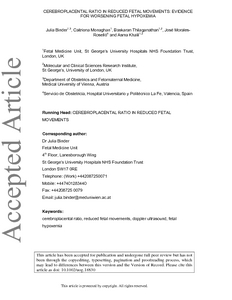Binder, J; Monaghan, C; Thilaganathan, B; Morales-Roselló, J; Khalil, A
(2018)
Reduced fetal movements and cerebroplacental ratio: evidence for worsening fetal hypoxemia.
Ultrasound Obstet Gynecol, 51 (3).
pp. 375-380.
ISSN 1469-0705
https://doi.org/10.1002/uog.18830
SGUL Authors: Khalil, Asma
![[img]](https://openaccess.sgul.ac.uk/109072/1.hassmallThumbnailVersion/Binder_et_al-2017-Ultrasound_in_Obstetrics_%26amp%3B_Gynecology.pdf)  Preview |
|
PDF
Accepted Version
Available under License ["licenses_description_publisher" not defined].
Download (1MB)
| Preview
|
Abstract
Objective
To investigate the fetal cerebroplacental ratio (CPR) in women presenting with reduced fetal movements (RFM).
Methods
This was a retrospective cohort study of data collected over an 8‐year period at a fetal medicine unit at a tertiary referral center. The cohort comprised 4500 singleton pregnancies presenting with RFM at or after 36 weeks' gestation and 1527 control pregnancies at a similar gestational age without RFM. Fetal biometry and Doppler parameters were recorded and converted into centiles and multiples of the median (MoM). CPR was defined as the ratio between the fetal middle cerebral artery (MCA) pulsatility index (PI) and the umbilical artery (UA) PI. Subgroup analysis for fetal size and for single vs multiple episodes of RFM was performed.
Results
Compared with controls, pregnancies with RFM had lower MCA‐PI MoM (median, 0.95 vs 0.97; P < 0.001) and CPR MoM (median, 0.97 vs 0.99; P = 0.018). Compared with women presenting with single episodes of RFM, pregnancies with multiple episodes (≥ 2 episodes) had lower CPR MoM (median, 0.94 vs 0.98; P = 0.003). On subgroup analysis for fetal size, compared with controls, appropriate‐for‐gestational‐age fetuses in the RFM group had lower MCA‐PI MoM (median, 0.96 vs 0.97; P = 0.003) and higher rate of CPR below the 5th centile (5.3% vs 3.6%; P = 0.015). Logistic regression analysis demonstrated an association of risk of recurrent RFM with maternal age (OR, 0.96; 95% CI, 0.93–0.99), non‐Caucasian ethnicity (OR, 0.72; 95% CI, 0.53–0.97), estimated fetal weight centile (OR, 1.01; 95% CI, 1.00–1.02) and CPR MoM (OR, 0.24; 95% CI, 0.12–0.47).
Conclusion
Pregnancies complicated by multiple episodes of RFM show significantly lower CPR MoM and MCA‐PI MoM compared with those with single episodes and controls. This is likely to be due to worsening fetal hypoxemia in women presenting with recurrent RFM.
| Item Type: |
Article
|
| Additional Information: |
This is the peer reviewed version of the following article: Binder, J. , Monaghan, C. , Thilaganathan, B. , Morales‐Roselló, J. and Khalil, A. (2018), Reduced fetal movements and cerebroplacental ratio: evidence for worsening fetal hypoxemia. Ultrasound Obstet Gynecol, 51: 375-380, which has been published in final form at http://doi.org/10.1002/uog.18830. This article may be used for non-commercial purposes in accordance with Wiley Terms and Conditions for Self-Archiving. |
| Keywords: |
cerebroplacental ratio, doppler ultrasound, fetal hypoxemia, reduced fetal movements, Obstetrics & Reproductive Medicine, 1114 Paediatrics And Reproductive Medicine |
| SGUL Research Institute / Research Centre: |
Academic Structure > Molecular and Clinical Sciences Research Institute (MCS) |
| Journal or Publication Title: |
Ultrasound Obstet Gynecol |
| ISSN: |
1469-0705 |
| Language: |
eng |
| Dates: |
| Date | Event |
|---|
| 7 March 2018 | Published | | 7 August 2017 | Published Online | | 24 July 2017 | Accepted |
|
| Publisher License: |
Publisher's own licence |
| PubMed ID: |
28782146 |
 |
Go to PubMed abstract |
| URI: |
https://openaccess.sgul.ac.uk/id/eprint/109072 |
| Publisher's version: |
https://doi.org/10.1002/uog.18830 |
Statistics
Item downloaded times since 16 Aug 2017.
Actions (login required)
 |
Edit Item |



